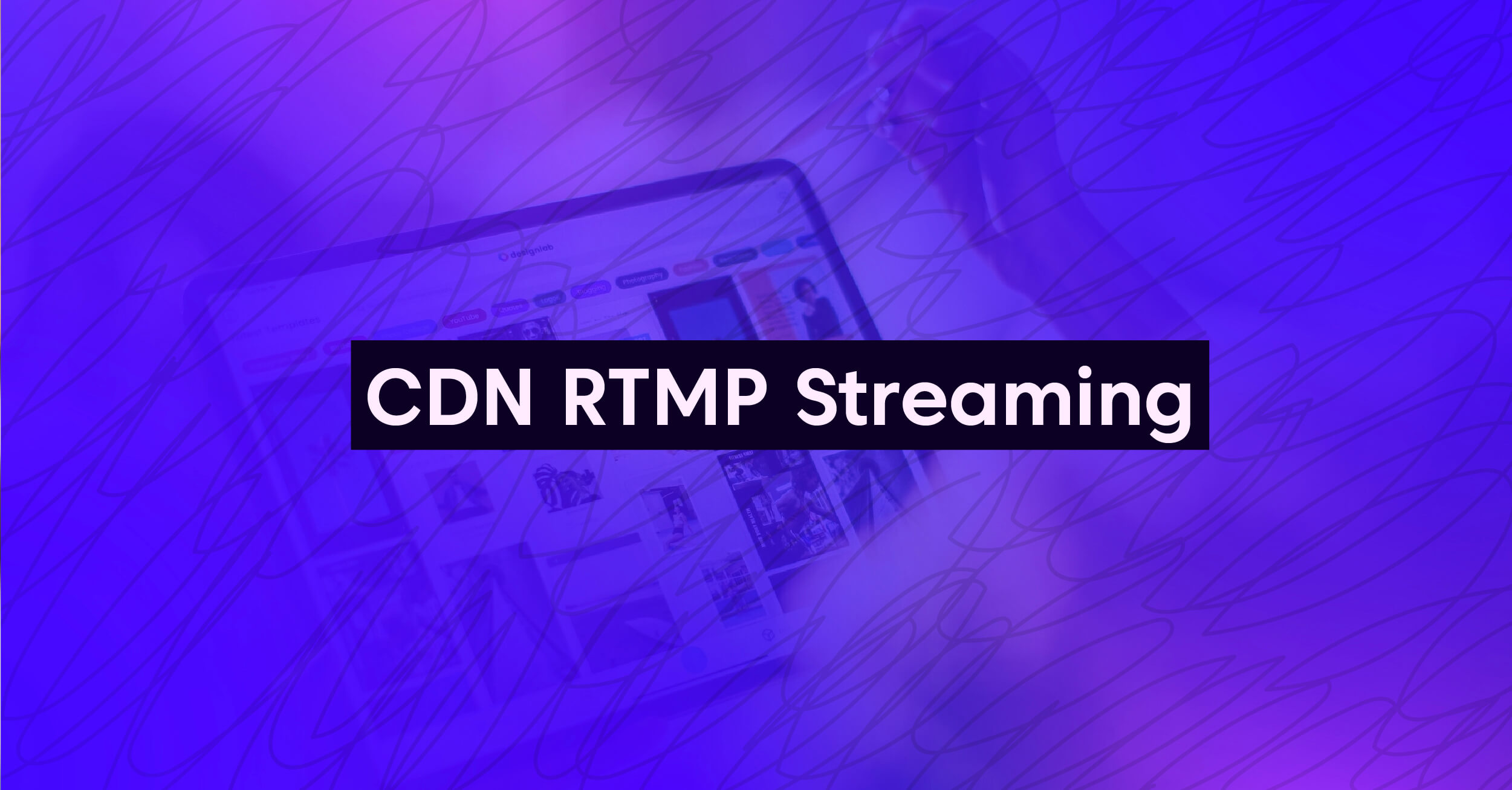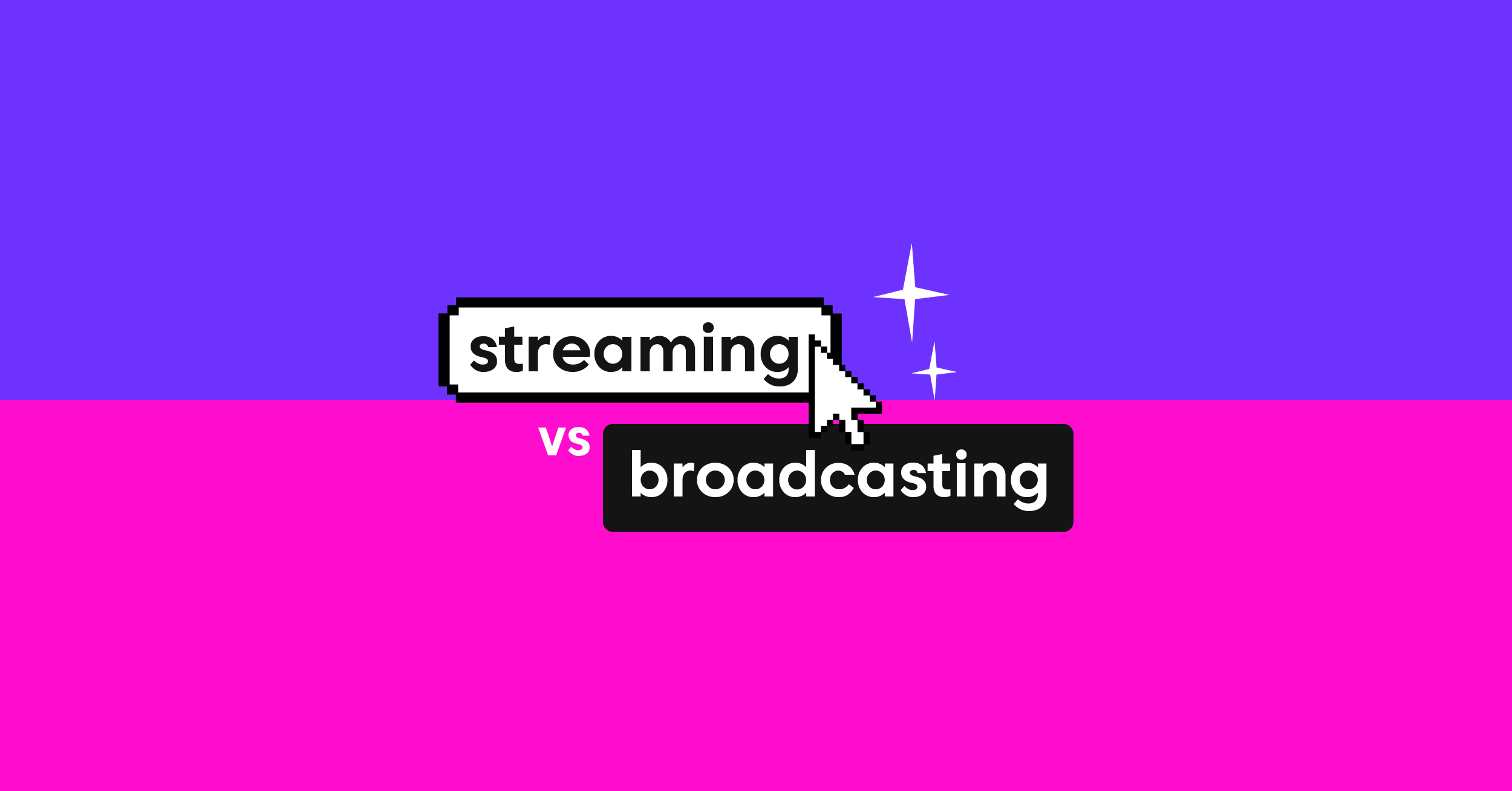RTMP Streaming: The Real-Time Messaging Protocol Explained
The concept of RTMP streaming emerged in the early 2000s, originating with the efforts of Adobe Systems. Its purpose was to establish a real-time data transfer method with a low-latency protocol, primarily catering to live streaming applications. RTMP operates by breaking down audio and video into small chunks, which are then transmitted promptly over a network connection using the TCP protocol.
A noteworthy benefit of RTMP is its capacity for achieving low latency, enabling almost instantaneous transmission of audio and video data. Consequently, it stands out as an exceptional choice for streaming live events like sports matches or music concerts.
To create an RTMP stream, there are several software tools available, including Castr. This tool presents an intuitive interface that simplifies the setup and management of your live streams. Despite the emergence of newer protocols like HLS and DASH, RTMP continues to hold significance in the realm of live streaming due to its low latency and compatibility with various devices.
Whether you are delivering coverage of a significant sports event or hosting a webinar, RTMP facilitates the real-time delivery of top-notch content to your audience.
What is CDN RTMP Streaming?

As a method of distributing online audio and video, CDN RTMP streaming has grown significantly in popularity. It has a low latency because it uses the RTMP to transport audio, video, and data in real-time. This functionality makes it ideal for online gaming and live video streaming.
For CDN RTMP streaming to function, several components come into play.
- Primarily, an RTMP server is necessary to oversee the streaming process. Acting as a central hub, the server collects the RTMP stream from the source, be it a software or hardware encoder, and effectively distributes it to viewers. As a result, the video stream is transmitted to multiple clients with utmost efficiency and reliability.
- CDN RTMP streaming works by establishing a TCP connection between the client and the server. The client sends an RTMP request to the server, specifying the RTMP URL and stream key. The server then processes the request and starts streaming video content in the specified streaming format. The transmitted data includes both video and audio data, ensuring a seamless streaming experience for the viewers.
- One of the advantages of CDN RTMP streaming is its compatibility with various platforms and devices. Many streaming platforms and servers accept RTMP streams, making it easy to reach a wide audience.
- Additionally, RTMP is supported by popular media players and web browsers, including Adobe Flash Player, which further enhances its accessibility.
- Another notable feature of CDN RTMP streaming is its support for adaptive bitrate streaming. This innovation enables the streaming server to adaptively modify the visual quality of the video depending on the viewer’s online connectivity, guaranteeing uninterrupted and seamless playback. This feature holds significant value for users accessing content through mobile gadgets or those with constrained data transfer capacities.
In recent years, alternative streaming protocols such as HLS and WebRTC HTTP ingest protocols have gained popularity. However, CDN RTMP streaming remains a reliable and widely used choice for many streaming applications due to its secure reliable transport of video and audio data.
Ultimately, CDN RTMP streaming stands as a robust and flexible streaming solution for transmitting real-time video, audio, and data. Its ability to lower latency, adjust bitrate streaming data rates, and function across multiple platforms makes it a favored option for various applications, such as online video streaming, interactive gaming, and live video streaming.
In an era of never-ending progress in streaming technology, CDN RTMP streaming remains a vital component in the constantly transforming domain of online content distribution or online media delivery.
How Does CDN RTMP Streaming Work?

The functionality of CDN RTMP streaming revolves around harnessing the capabilities of the RTMP to promptly transmit top-notch content data to users. To initiate the streaming process, users use specialized software designed for streaming or an RTMP encoder to capture and encode the video data. Subsequently, the encoded information is transmitted to an RTMP server, which functions as a central media server facilitating the streaming process.
By giving the server URL and a stream key, the user creates a TCP connection with the RTMP server to begin streaming. This connection allows for the secure and reliable transport of video and audio data. The RTMP server receives the stream and distributes it to various streaming servers located around the world.
CDN RTMP streaming is ideal for live video streaming due to its low latency capabilities. It supports adaptive bitrate streaming, which ensures that viewers with varying internet speeds can receive a smooth streaming experience. This widely used streaming solution is compatible with popular streaming platforms that accept RTMP streams, including social media platforms.
Overall, CDN RTMP streaming provides a seamless and efficient method for delivering video content to audiences on web browsers and mobile gadgets. It offers a secure and reliable stream transport while maintaining high video quality and minimizing data transmission delays. Thanks to RTMP encoder support, this streaming format has become the norm for all online streaming, including live and on-demand content.
The Benefits of Using CDN RTMP Streaming for Your Business

CDN RTMP streaming presents a myriad of benefits for your business.
- Among its key benefits is the enhancement of video quality and faster load times for your audience. By using a network of servers worldwide, CDN RTMP streaming reduces buffering and enhances performance, even for those with slower internet connections.
- Moreover, this streaming method bolsters content security by encrypting data during transmission, thus protecting against cyber breaches, hacking, piracy, and unlawful distribution.
- By leveraging CDN RTMP streaming, you can guarantee prompt and efficient delivery of your videos to a global audience, thereby augmenting your brand’s online visibility and reputation.
- Additionally, this approach can yield cost savings by minimizing bandwidth requirements for content delivery.
Overall, incorporating CDN RTMP streaming into your business strategy facilitates improved audience reach, engagement, and an improved user experience.
How to Implement CDN RTMP Streaming for Your Business
Implementing CDN RTMP streaming offers a unique opportunity to enhance the quality and reliability of your video content.
-
Choosing the Right CDN Provider
To begin, selecting a CDN provider that aligns with your specific requirements becomes crucial. Seek out a provider that presents top-notch streaming with low-latency streaming, coupled with unfailing technical support and an intuitive interface.
-
Setting up your Streaming Infrastructure
After finalizing your CDN provider, the subsequent step involves establishing your streaming infrastructure. This task encompasses tasks such as configuring your media server, setting up caching servers, and optimizing your network for seamless streaming traffic.
-
Integrating with your Website or Platforms
Furthermore, integrating your streaming solution with your website or platform demands the utilization of custom APIs or plugins.
To ensure optimal performance and an outstanding user experience, it remains imperative to regularly test and optimize your streaming solution. This encompasses constant monitoring of real-time analytics and implementing necessary adjustments to your configuration or infrastructure. By adopting the correct approach and using the right tools, the implementation of CDN RTMP streaming can elevate the quality of your business’s video content to unprecedented heights.
Best Practices for Optimizing Your CDN RTMP Streaming Performance
Optimizing your CDN RTMP streaming performance requires implementing best practices that ensure the efficient delivery of your live video content. RTMP, a popular streaming protocol that supports low-latency streaming, is perfect for live video broadcasts.
- To get started, you need a reliable RTMP server and compatible streaming software encoder. These encoders support RTMP and allow you to encode and transmit your video and audio data seamlessly.
- Additionally, consider using adaptive bitrate streaming to maintain video high quality across different network conditions.
- By leveraging RTMP’s secure and reliable transport, you can live stream video to various platforms, including social media platforms that accept RTMP streams.
- Ensure your streaming servers are optimized for RTMP ingestion and use a secure stream key and server URL for authentication.
- To enhance performance, employ media servers that support RTMP encoding and HTTP live streaming (HLS) for broader compatibility with online browsers and mobile gadgets.
By following these best practices, you can optimize your CDN RTMP streaming performance and deliver an exceptional live streaming experience to your audience.
Conclusion: The Future of Streaming Technology with CDN RTMP Streaming
One of the most significant advancements in the field of streaming technology is CDN RTMP streaming. A distributed network of servers strategically positioned throughout various locations is known as a CDN or content delivery network. RTMP, one of the most prominent streaming protocols, enables seamless transmission of video data over the internet, ensuring an agile and interactive streaming experience.
CDN RTMP streaming has revolutionized the way we consume and distribute streaming content. It has grown into the preferred option for many streaming platforms and online streaming services due to its low latency and reliable secure transport. Contrary to traditional HTTP live streaming, which depends on HTTP, CDN RTMP streaming leverages the power of RTMP servers to effectively stream video data to viewers.
One of the key advantages of CDN RTMP streaming is its ability to support adaptive bitrate streaming. In order to provide a seamless watching experience, the streaming software can modify the video stream’s quality according to the user’s internet connection. Additionally, CDN RTMP streaming allows for bidirectional message multiplex service, enabling real-time communication between the client and server.
The rise of mobile devices and web browsers as primary streaming platforms has further propelled the demand for CDN RTMP streaming. With the support of RTMP encoders, users can easily start streaming video content from their mobile devices to a global audience. Furthermore, many social media platforms and streaming servers accept RTMP streams, making it a versatile and widely compatible streaming solution.
To utilize CDN RTMP streaming, users need a server URL and a unique stream key, which ensures secure stream transmission. By leveraging hardware encoders or software encoders that support RTMP encoding, content creators can deliver live video and audio data seamlessly. The flexibility of CDN RTMP streaming also allows for on-demand streaming, giving users the freedom to access the content at their convenience.
While CDN RTMP streaming remains a dominant force, alternative streaming protocols such as WebRTC and HTTP ingest protocols have emerged. However, CDN RTMP streaming continues to thrive due to its reliability, low latency, and widespread support. It is apparent that CDN RTMP streaming will keep playing a crucial role in shaping how we stream and consume video content as the landscape of streaming technology advances.
Frequently Asked Questions
What is an RTMP server?
An open-source protocol called Real-Time Messaging Protocol (RTMP), which is owned by Adobe, is made to stream audio and video while preserving low-latency connections. Users can live stream video and audio after clients establish a connection with an RTMP server via a handshake.
A typical stream using RTMP protocol in Castr?
Most live streaming services and encoders today are using the RTMP format. RTMP is highly effective in maintaining low latency for streams with stable audio and video connections.
As a result, the majority of the live-streaming community is choosing to transmit the media to an RTMP server to best leverage the protocol’s advantages. The streamers will then transcode it into other technologies like HLS, DASH, or SRT for multi-device delivery.
Today, a stream typically combines RTMP and HLS protocols for low latency and adaptive quality for the viewers.
What are the Encoders Compatible with RTMP?
Various encoder solutions, both in terms of hardware and software, offer support for RTMP protocol. Among them are Adobe Media Encoder, OBS Studio, Elemental Server, TriCaster, Wirecast, vMix, TeraDek, Wowza Streaming Engine, and Niagara Video.
What Is an RTMP URL?
An RTMP URL serves as an exclusive identifier utilized for streaming real-time video content across various platforms. Generally, it contains an IP address, a domain name, and a specific port number.
What are the Variations of RTMP?
Variations of RTMP encompass the following:
Real-Time Messaging Protocol Server (RTMPS):
RTMP with Encryption (RTMPS) – Similar to RTMP, this version incorporates encryption by enabling secure sockets layer (SSL) and Transport Layer Security (TLS). It caters to Flash player-enabled users, ensuring the prevention of data tampering or unauthorized access during transmission.
Encrypted Real-Time Messaging Protocol (RTMPE):
User Datagram Protocol (UDP) and Transport Control Protocol (TCP) are both used by the versatile streaming protocol RTMPE to send data. RTMPE uses Adobe’s proprietary encryption to encrypt all data transmissions, preventing unauthorized access and tampering.
Real-Time Messaging Protocol Tunnel (RTMPT):
RTMPT employs a tunneling mechanism to bypass firewalls that typically block RTMP traffic. In practice, clients initiate a modified HTTP request to the server, which responds with a comparable HTTP transmission. Once a connection is established using a session ID, data transmission can commence between the client and server.
Real-Time Media Flow Protocol (RTMFP)
Enhanced Media Streaming with RTMP (RTMFP) – RTMFP builds upon RTMP by utilizing UDP as an alternative encoding format, allowing for superior performance in media streaming.
What is an RTMP encoder?
An RTMP encoder is a specialized software or hardware tool that transforms audio and video content into the RTMP format. Its main job is to convert the content data from sources like cameras or microphones into a format that can be streamed and transmitted over the internet via the RTMP protocol.









